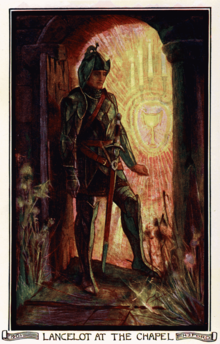
Back لانسلوت Arabic Лансэлот Byelorussian Ланселот Bulgarian Lanselod Breton Lancelot Catalan Lancelot Czech Lawnslot Welsh Lancelot Danish Lancelot German Λάνσελοτ Greek
| Lancelot | |
|---|---|
| Matter of Britain character | |
 | |
| First appearance | Erec and Enide |
| Created by | Possibly Chrétien de Troyes |
| Based on | Uncertain origins |
| In-universe information | |
| Alias | White Knight, Black Knight, Red Knight, Wicked Knight |
| Title | Prince, Sir |
| Occupation | Knight-errant, Knight of the Round Table |
| Weapon | Secace (Seure),[1] Aroundight[2] |
| Family | Ban, Elaine of Benoic, Lady of the Lake, Hector de Maris |
| Spouse | Elaine of Corbenic |
| Significant other | Guinevere, possibly Galehaut |
| Children | Galahad |
| Relatives | Lionel, Bors, Bleoberis |
| Religion | Christian |
| Origin | Benoic (in today's northeastern France) |
| Nationality | Either Celtic Briton or French |
Lancelot du Lac (French for Lancelot of the Lake), also written as Launcelot and other variants,[a] is a character in some versions of Arthurian legend where he is typically depicted as King Arthur's close companion and one of the greatest Knights of the Round Table. In the French-inspired Arthurian chivalric romance tradition, Lancelot is an orphaned son of King Ban of the lost kingdom of Benoic, raised in a fairy realm by the Lady of the Lake. A hero of many battles, quests and tournaments, and famed as a nearly unrivalled swordsman and jouster, Lancelot becomes the lord of the castle Joyous Gard and personal champion of Arthur's wife, Queen Guinevere, despite suffering from frequent and sometimes prolonged fits of madness. But when his adulterous affair with Guinevere is discovered, it causes a civil war that, once exploited by Mordred, brings an end to Arthur's kingdom.
Lancelot's first datable appearance as main character is found in Chrétien de Troyes' 12th-century French poem Lancelot, the Knight of the Cart, which already centered around his courtly love for Guinevere. However, another early Lancelot poem, Lanzelet, a German translation of an unknown French book, did not feature such a motif and the connections between the both texts and their possible common source are uncertain. Later, his character and story was expanded upon Chrétien's tale in the other works of Arthurian romance, especially through the vast Lancelot-Grail prose cycle that presented the now-familiar version of his legend following its abridged retelling in Le Morte d'Arthur. There, Lancelot's and Lady Elaine's son Galahad, devoid of his father's flaws of character, becomes the perfect knight that succeeds in completing the greatest of all quests, achieving the Holy Grail when Lancelot himself fails due to his sins. Both loyal and treasonous, Lancelot has remained a popular character for centuries and is often being variably reimagined by modern authors.
- ^ Bane, Theresa (29 May 2020). Encyclopedia of Mythological Objects. McFarland. ISBN 9781476639208 – via Google Books.
- ^ Ellis, George, ed. (1805). "Sir Bevis of Hamptoun". Specimens of early English metrical romances. Vol. 2. London: Longman, Hurst, Rees, & Orme. pp. 165–166.
Cite error: There are <ref group=lower-alpha> tags or {{efn}} templates on this page, but the references will not show without a {{reflist|group=lower-alpha}} template or {{notelist}} template (see the help page).
© MMXXIII Rich X Search. We shall prevail. All rights reserved. Rich X Search